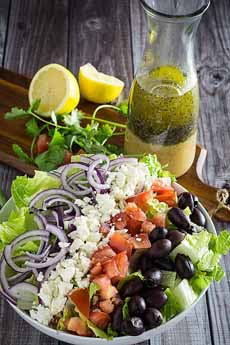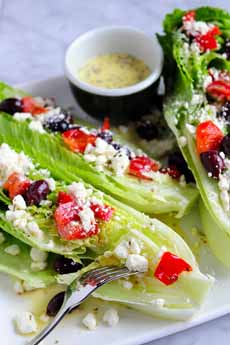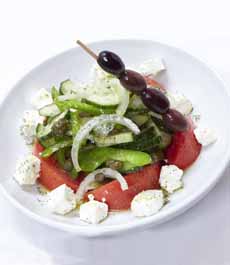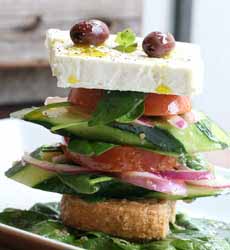TIP OF THE DAY: Authentic Greek Salad Recipe & The “American” Greek Salad
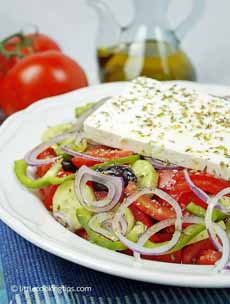 [1] The real deal: an authentic Greek salad from Little Cooking Tips. Here’s the recipe.
|
Our favorite luncheon salad is a Greek salad, most often homemade, sometimes at a diner or similar casual spot.
We follow the latter’s recipe: romaine, tomatoes, feta cheese, cucumber, green bell pepper, red onion, kalamata olives, peperoncini (the italian spelling; pepperoncini is the English spelling), and hopefully, a couple of grape leaves and pita or crusty bread on the side. For seasoning, a sprinkle of oregano and cruets of oil and red wine vinegar. We’ve been known to substitute balsamic vinegar for the conventional acidic red wine vinegar, and add fresh basil or other herb when we have it. We especially love a Greek salad in the summer, when the seasonal tomatoes are a joy in of themselves. Bloggers Mirella and Panos of Little Cooking Tips says: “The authentic horiatiki [Greek salad] is a very specific salad, with very specific ingredients. See the recipe below, from Chef Amanda Cohen. The Authentic Greek Salad Ingredients Of course, there are other popular salads in Greece, including: The other ingredients in Cypriot salad: finely chopped tomatoes (not sliced, as in horiatiki, capers, cucumbers, onions and feta cheese, dressed with olive oil and lemon or red wine vinegar. The bell peppers and olives: lost in translation. Horiatiki is primarily a summer dish, using lush tomatoes off the vine. Since lettuce only grows in Greece during the cooler, winter months, a horiatiki salad does not include lettuce (source). And while horiatiki is ubiquitous in Greece, it is a relatively new combination. Some of the ingredients are thousands of years old, others as new as the last century. |
|
|
Her “American Greek salad” is layered with some ingredients that no Greek chef has likely thought of (photos #5 and #6). “This recipe, while it might look intimidating, makes this salad a party on your plate,” says Chef Amanda. “Sumac and za’atar give this recipe its zip. Sumac is a dried berry with a bright citrusy flavor, and za’atar is a vibrant, intensely herbal seasoning. You can find them at any Middle Eastern or Indian grocery store. “You can always leave them out, but this salad is a lot more fun if they’re invited to the party.” In addition to sumac and za’atar, this recipe invites pickled onions and fried onion rings with a preserved lemon drizzle. Thanks to Wüsthof for the recipe. Wüsthof is Chef Amanda’s cutlery of choice; and THE NIBBLE has more than a few in its knife rack, as well. Brush up on your knife skills with these Wüsthoff videos. |
||
|
Ingredients For 4 Servings
For The Pickled Onions 1. MAKE the pickled onions. Massage 1 tablespoon of the salt into the onions. Keep massaging until liquid starts to seep out of the onions and then squeeze all of the liquid out. Wash the onions a few times and repeat a second time. Then, add 1 tablespoon of the salt and ¼ cup of the lime juice to the onions and let sit for a few hours. Squeeze all of the liquid out of the onions. Repeat the above sequence. When ready, onions should be a bright pink color. If they are not, repeat the process again. |

|
|
|
2. MAKE the dressing. In a blender mix the garlic, mustard, red wine vinegar, lemon juice, lemon zest, salt and black pepper. Slowly stream in the olive oil. Add the oregano and blend until it is broken up into small pieces. 3. MAKE the preserved lemon mayonnaise: Place all ingredients in blender and blend until very smooth. Put the mixture into a squeeze bottle. 4. MAKE the salad. In a bowl mix the tomatoes, cucumbers, fennel, herbs and olives. Add the feta and adjust the salt levels. 5. MAKE the mushroom rings: Slice the mushrooms into ¼” thick rings and punch the centers out, leaving about ¼” for an outer ring, so that each ring is ¼” thick and ¼” wide. Heat the oil in a heavy-bottomed pot until it reaches 375°F. Mix the flour and the seltzer in a bowl. In a separate bowl mix the panko, the salt, the sumac and za’atar. Dip the rings in the seltzer mixture first and then dip them in the panko mixture. Fry in batches for about 2-3 minutes each. When done, the mushrooms should be golden brown on the outside. 6. ASSEMBLE: Toss the salad with the dressing; taste and adjust the salt level. Divide the salad onto four plates. Place 4 onion rings on top of each salad. Squeeze a few lines of the preserved lemon mayo across the salad. Garnish: Sprinkle with the sumac, za’atar and the pistachios. Place a tablespoon of the pickled onions on the side of the plate. Microwave the pita and you’re ready to eat!
|
||
